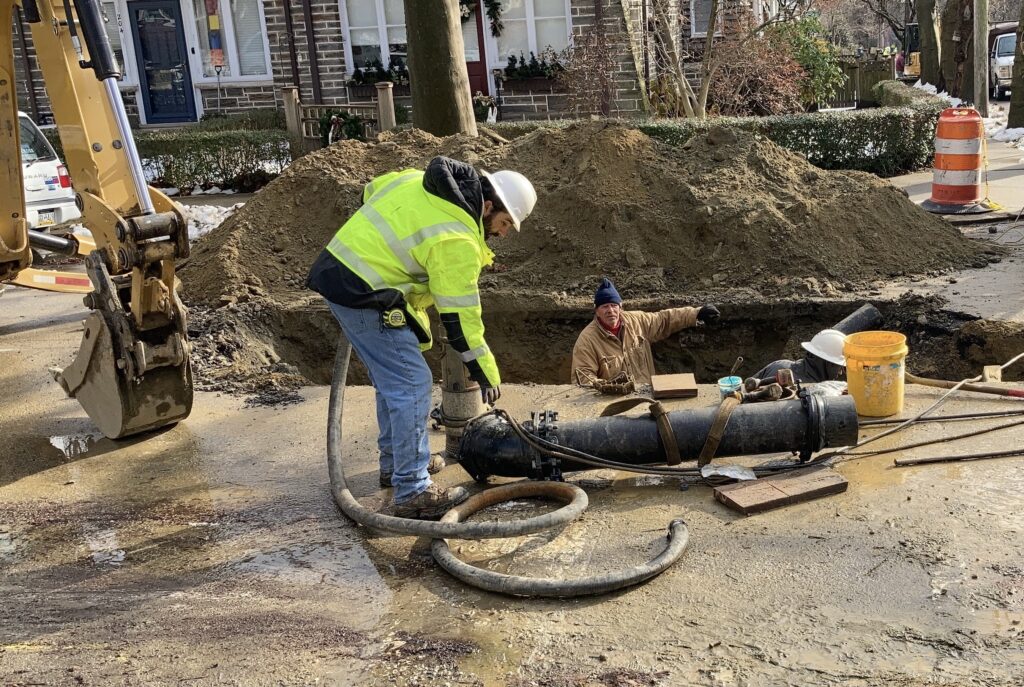Thanks to the workers of Seravalli Contractors for putting in our new water main and for their patience in explaining the construction process
Nearly 9 AM this morning your correspondent went to the corner of Ardleigh Street and East Highland Avenue, the time the water was due to cut off to all the houses on our block. They were making the switch from the new water main they had laid on Ardleigh Street to our existing water connector line beneath Highland Avenue. A foreman and the workers amiably indulged my questions and so I share what I learned.
The large crew was assembled working into tow teams on different sides of the intersection. First they took diameter measurements of the existing connector pipe now exposed lying 4 feet down. Excavation had preceded by a day or so. According to the foreman, connector pipes can range from 6 to 8 inches in diameter. I believe ours measured 8 inches. “Feeder” or distribution mains can measure 12 to 16 inches in diameter. ( Before excavation began, I saw large black pipes staged excavation along Ardleigh Street; the ones farther south between Southampton Ave and Gravers Lane, appeared considerably larger than the ones, the next block up, between Gravers Lane and Highland Ave)
A worker then began abrading the existing connector pipe at the point it would be cut. Meanwhile another worker was sawing sections of new pipe to adjoin the existing connector pipe on or street with the main. Pipes are now made of ductile iron said the foreman because they are stronger and more durable than the existing cast iron pipes. He relayed that the stretch of Ardleigh Street north of Highland Avenue was more challenging to excavate because there were a lot of stones in the ground. This Wissahickon schist is commonly seen in our 100 or so year- old homes. Your correspondent saw connector pipes being hoisted, removed then rehoisted into the trenches. A pump was put into place to pump out any water that might accumulate during the process. I could not approach close enough to see the worker affix the collars to complete the pipe connections.
Farther down Ardleigh street, after the main had been laid, workers were replacing connections from individual houses along the street to the new main with three-quarter inch copper piping by snaking it through to the main. The workmen looked like prairie dogs popping up and down from the small pits outside each house by the curb. A worker said people may complain that their street gets dug up three separate times because they might not understand the the multi step process. Temporary, large stone asphalt is used at the preliminary stages before the final fill. When all pipe laying and connection work is done, a layer of sand will be poured on top of the pipe followed by a couple feet of soil. Then comes a layer of stones, then a layer of concrete and finally, the street is repaved with the a finer asphalt material and smoothed down with a roller.
I editorialize: for the customer, the only inconvenience is a few weeks of stepping around construction equipment and navigating some muddy streets. A City of Philadelphia Water Department postcard stuck in our door advised us that water would be shut off on December 22, 2020 from 9 am to 4 pm but in actuality, the water was shut off well after 9 and restored much before 4. Considering the size of the project, interruption to our service was a mere few hours. The true value of a consistent supply of clean water for our health, for our lives, is far beyond the very modest water rates we pay. Rates are so low that some of us think nothing of watering our lawns water or filling our swimming pools with water that is good enough to drink!

